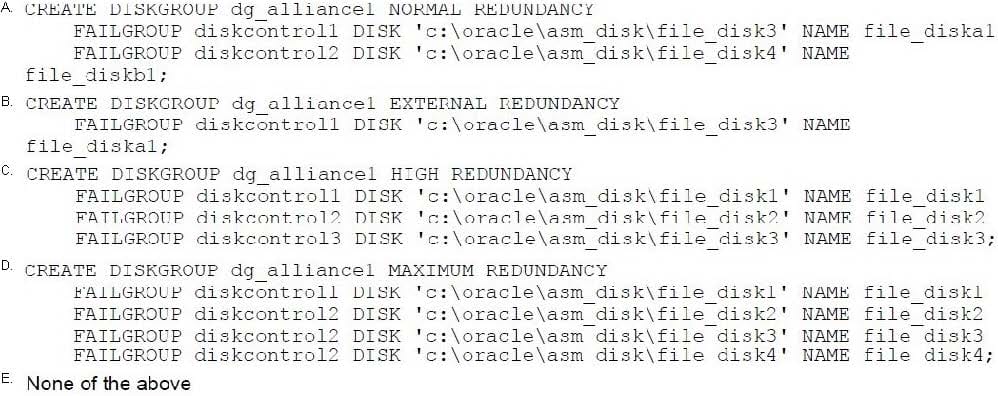Exam Details
Exam Code
:1Z0-053Exam Name
:Oracle Database 11g: Administration IICertification
:Oracle CertificationsVendor
:OracleTotal Questions
:736 Q&AsLast Updated
:Mar 26, 2025
Oracle Oracle Certifications 1Z0-053 Questions & Answers
-
Question 661:
Which background process coordinates the rebalance activity for disk groups?
A. ORBn
B. OSMB
C. RBAL
D. ASMn
-
Question 662:
To reference existing ASM files, you need to use a fully qualified ASM filename. Your development database has a disk group named DG2A, the database name is DEV19, and the ASM file that you want to reference is a datafile for the USERS02 tablespace.
Which of the following is a valid ASM filename for this ASM file?
A. dev19/+DG2A/datafile/users02.701.2
B. +DG2A/dev19/datafile/users02.701.2
C. +DG2A/dev19/users02/datafile.701.2
D. +DG2A.701.2
E. +DG2A/datafile/dev19.users.02.701.2
-
Question 663:
How can you reverse the effects of an ALTER DISKGROUP ... DROP DISK command if it has NOT yet completed?
A. Issue the ALTER DISKGROUP ... ADD DISK command.
B. Issue the ALTER DISKGROUP ... UNDROP DISKS command.
C. Issue the ALTER DISKGROUP ... DROP DISK CANCEL command.
D. Retrieve the disk from the Recycle Bin after the operation completes.
-
Question 664:
As DBA for the Rebalance, you have decided that you need to facilitate some redundancy in your database. Using ASM, you want to create a disk group that will provide for the greatest amount of redundancy for your ASM data (you do not have advanced SAN mirroring technology available to you, unfortunately).
Which of the following commands would create a disk group that would offer the maximum in data redundancy?

A. B. C. D. E.
-
Question 665:
When starting up your ASM instance, you receive the following error: SQL> startup pfile=$ORACLE_HOME/dbs/init+ASM.ora ASM instance started
Total System Global Area 104611840 bytes Fixed Size 1298220 bytes Variable Size 78147796 bytes ASM Cache 25165824 bytes
ORA-15032: not all alternations performed ORA-15063: ASM discovered an insufficient number of disks for diskgroup "DGROUP3" ORA-15063: ASM discovered an insufficient number of disks for diskgroup "DGROUP2" ORA-15063: ASM discovered an insufficient number of disks for diskgroup "DGROUP1"
In trying to determine the cause of the problem, you issue this query: SQL> show parameter asm

What is the cause of the error?
A. The ASM_DISKGROUPS parameter is configured for three disk groups: DGROUP1, DGROUP2, and DGROUP3. The underlying disks for these disk groups have apparently been lost.
B. The format of the ASM_DISKGROUPS parameter is incorrect. It should reference the disk group numbers, not the names of the disk groups
C. The ASM_POWER_LIMIT parameter is incorrectly set to 1. It should be set to the number of disk groups being attached to the ASM instance.
D. The ASM_DISKSTRING parameter is not set; therefore disk discovery is not possible.
E. There is insufficient information to solve this problem.
-
Question 666:
When an ASM instance receives a SHUTDOWN NORMAL command, what command does it pass on to all database instances that rely on the ASM instances disk groups?
A. TRANSACTIONAL
B. IMMEDIATE
C. ABORT
D. NORMAL
-
Question 667:
Which initialization parameter in an ASM instance specifies the disk groups to be automatically mounted at instance startup?
A. ASM_DISKMOUNT
B. ASM_DISKGROUP
C. ASM_DISKSTRING
D. ASM_MOUNTGROUP
-
Question 668:
What is the default AU size of an ASM disk group? What is the maximum AU size in an ASM disk group?
A. 100KB default, 10TB maximum
B. 256KB default, 1024MB maximum
C. 10MB default, 126PB maximum
D. 64KB default, 1EB maximum
E. 1MB default, 64MB maximum
-
Question 669:
What is the result of increasing the value of the parameter ASM_POWER_LIMIT during a rebalance operation?
A. The ASM rebalance operation will likely consume fewer resources and complete in a shorter amount of time.
B. The ASM rebalance operation will consume fewer resources and complete in a longer amount of time.
C. The ASM rebalance operation will be parallelized and should complete in a shorter amount of time.
D. There is no ASM_POWER_LIMIT setting used in ASM.
E. None of the above
-
Question 670:
Which of the following is a benefit of ASM fast disk resync?
A. Failed disks are taken offline immediately but are not dropped.
B. Disk data is never lost.
C. By default, the failed disk is not dropped from the disk group ever, protecting you from loss of that disk.
D. The failed disk is automatically reformatted and then resynchronized to speed up the recovery process.
E. Hot spare disks are automatically configured and added to the disk group.
Related Exams:
1Z0-020
Oracle8i: New Features for Administrators1Z0-023
Architecture and Administration1Z0-024
Performance Tuning1Z0-025
Backup and Recovery1Z0-026
Network Administration1Z0-034
Upgrade Oracle9i/10g OCA to Oracle Database OCP1Z0-036
Managing Oracle9i on Linux1Z0-041
Oracle Database 10g: DBA Assessment1Z0-052
Oracle Database 11g: Administration Workshop I1Z0-053
Oracle Database 11g: Administration II
Tips on How to Prepare for the Exams
Nowadays, the certification exams become more and more important and required by more and more enterprises when applying for a job. But how to prepare for the exam effectively? How to prepare for the exam in a short time with less efforts? How to get a ideal result and how to find the most reliable resources? Here on Vcedump.com, you will find all the answers. Vcedump.com provide not only Oracle exam questions, answers and explanations but also complete assistance on your exam preparation and certification application. If you are confused on your 1Z0-053 exam preparations and Oracle certification application, do not hesitate to visit our Vcedump.com to find your solutions here.